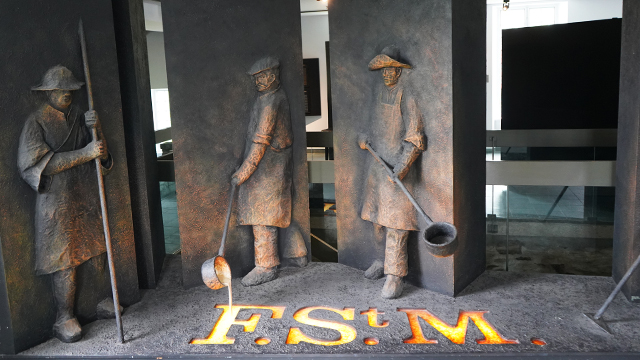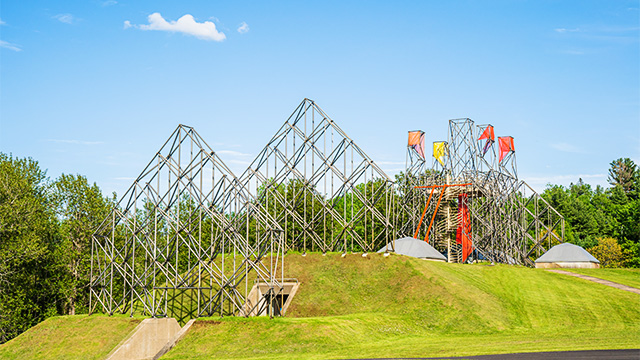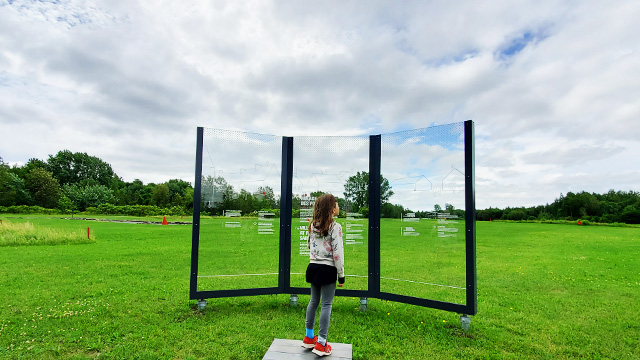
Exhibitions
Forges du Saint-Maurice National Historic Site
Make the most of your visit to Forges du Saint-Maurice National Historic Site by visiting the three permanent exhibitions.
No access
For safety and conservation reasons, the industrial valley area between the upper and lower forges and the trails in this area are closed. The trails leading to the Saint-Maurice River are also closed. Thank you for your cooperation.
Permanent exhibition at the Ironmaster’s House

Your first stop upon arriving at the Forges du Saint-Maurice National Historic Site should be the Ironmaster’s House.
Our guides will be on hand to welcome you and give you updates about the activities available and the accessible facilities.
The Ironmaster’s House, which once was a private residence, an administrative centre, a store and a warehouse, now hosts a series of exhibitions which recount the exceptional history of the Forges du Saint-Maurice.
After an overview of the three most important historic persons in the company's history and the Forges industrial community on the first floor, head down into the original cellars of the vast building.
This is where you'll find the products that have made the Forges famous for over 150 years.
The exhibition is divided into thematic sections representing three production periods:
- The Ironworks and war, ou la satisfaction des besoins du roi de France
- The Ironworks and colony for the country's development
- The Ironworks and industry in an effort to modernize iron and steel production in Canada
Audience: all ages, but particularly for those aged 16 and over who enjoy reading
Location: on the first floor and in the cellars of the Ironmaster’s House
Languages offered: French and English
Accessibility: the elevator to the cellars has been damaged by recent rains and is out of service indefinitely. It is therefore necessary to use the staircase, which has several steps. The exhibition takes place in a slightly darkened room. There are interpretive panels to read, objects to see and visual information, but no audio description.
Permanent exhibition at the Blast Furnace

Explore this intriguing structure to discover how thousands of tons of cast iron, an essential raw material for the manufacture of castings and iron objects, were produced here over more than 150 years.
What's inside:
wander around the vast exhibition featuring scenographic displays and interpretive panels that tell you more about historic moments, archaeological remains and the various objects made over the years. You can also catch a glimpse of the founder's house at the far end.
Don't miss the interactive 1600°C Trial by Fire! Follow the instructions of the foundry master and try your hand at the various stages of cast-iron production.
What's outside: climb to the top for a panoramic view of the industrial village remains. You'll find yourself where the blast furnace chimney once stood. You'll also see metal structures that express the exterior volumetry of the various buildings that once surrounded the Blast Furnace, forming a complex whole.
Audience: all ages
Location: in the Blast Furnace opposite the Ironmaster’s House
Languages offered: English and French
Accessibility: : the exhibition takes place in a slightly darkened room. There are interpretive panels to read, objects to see and visual information, but no audio description. The 1600°C Trial by Fire is located on a platform that requires descending steps.
Permanent exhibition of remains

For safety and conservation reasons, part of this outdoor exhibition is temporarily inaccessible, as the industrial valley area and its trails are closed.
Stroll along the Culture trail, a path dotted with interpretive panels that leads to the heart of the historic site, archaeological remains and the main buildings. Stand behind the glass panels to see the buildings as they stood in the 19th century.
See more details in the Trails section.
Audience: all ages
Location: outdoors. The panels showing the village at Forges du Saint-Maurice are near the Ironmaster’s House. Panels presenting the lower forge, the mill and the upper forge are located in the industrial valley, along the Culture trail.
Languages offered: French and English
Accessibility: the exhibition takes place outdoors and can be viewed by following an easy 1.29-kilometre compacted gravel loop. There are interpretive panels to read, buildings to see and visual information, but no audio description. The culture trail has a gradient of 8% to 12% (335 metres) and a staircase with 125 steps.
Related links
- Date modified :